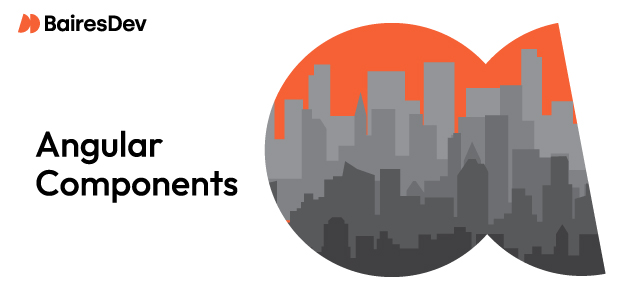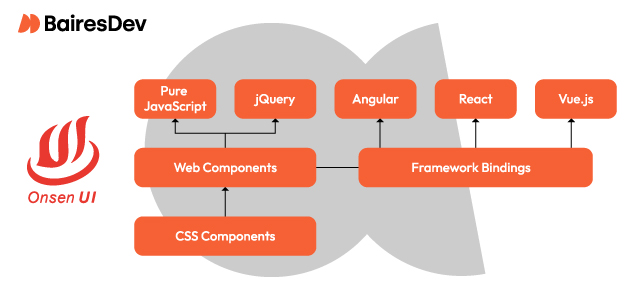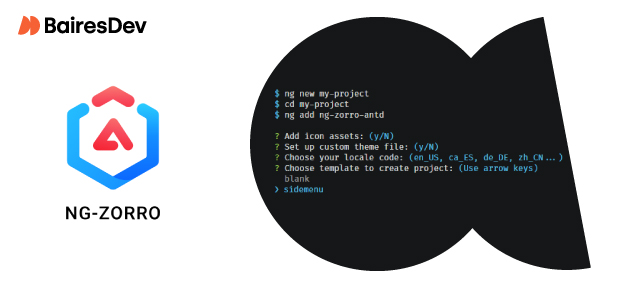Angular is one of the most popular frameworks for front-end solutions. With a plethora of component libraries at our disposal, which ones should we choose?

Welcome to the world of Angular UI component libraries and frameworks! As a technology expert or enthusiast, you know that having access to the right tools and resources can make all the difference when it comes to creating an amazing user experience. With so many options available, it can be difficult to decide which library or framework is best for your project. That's why we've put together this comprehensive guide on the top Angular UI component libraries and frameworks for 2023.
What are the most popular Angular components?

Angular is a popular open-source web application framework developed by Google and commonly used by an Angular development company. It is used to create dynamic single page applications and mobile applications. Angular components, which are the building blocks of an Angular application within the scope of an Angular development company, provide structure and functionality to the application. Components are reusable pieces of code that can be used in multiple places in an application, which makes them incredibly useful for developers at an Angular development company who want to create complex applications quickly with minimal effort.
Angular Material
Angular Material is a UI component library created by Google for Angular applications. It is designed to make development faster and more efficient by providing a set of easy-to-use tools that can be applied across multiple projects without having to rewrite code every time. Since its initial release in 2014, the library has grown significantly in terms of features offered and popularity among developers around the world due to its ease of use when compared to other frameworks like React or Vue.js, as well as the fact that it is supported by Google.
Material Interface Features
- Responsive layout
- Flexible components
- Theme support
- Accessibility support
- Internationalization (i18n)
- Animations
- Drag and drop
- Virtual scrolling
- Network system
Material UI Components
- autocomplete
- Selection box
- Date picker
- Form field
- Prohibited
- radio button
- Select
- Slider
- Toggle slide
- Menu
- toolbar
- Progress bar
- Dialogue
- Cafeteria
- Virtual scrolling
- Expansion panel
- Tree
- Grid List
- Guides
- Step by step
- And many more!
Material Design Startup
MDB is a front-end framework based on the popular Bootstrap library that combines the power of Material Design with the flexibility and extensibility of Bootstrap. It provides developers with an easy way to create modern web apps that are responsive and look great on any device, as well as built-in support for a Sass preprocessor for customizing stylesheets. The MDB also includes extensive documentation and tutorials to help developers get up and running quickly.
Material Design startup features
- Responsive design
- Pre-built components
- Customizable colors and fonts
- Cross-browser compatibility
- Easy integration with other frameworks and libraries
Material Design startup components
- Alerts
- Badges
- Bread crumbs
- Buttons
- Cards
- Carousels
- Collapse
- Dropdown menus
- Forms
- Icons
- Input groups
- Modals
- Navigation Bars
- Pagination
- Popovers
- Progress Bars
- Tables
- Guides
- Tooltips
- Typography
AG grade
AG Grid is an advanced data grid web component that provides a wide range of features for displaying and manipulating large data sets. It supports multiple columns, custom cell renderers, multiple data sources, charting libraries like D3.js and Highcharts, and comprehensive documentation and examples.
AG Grid Features
- Advanced Filtering: AG Grid offers advanced filtering capabilities, allowing users to filter data based on multiple criteria such as text, number range, date range, and more.
- Grouping and aggregation: AG Grid allows users to group and aggregate data in a variety of ways, including summing, counting, and averaging values in columns or rows.
- Pinning Columns: Users can pin columns to the left or right side of the grid for easier access when scrolling horizontally through large sets of data.
- Row Reordering and Sorting: AG Grid allows users to reorder rows by dragging them into place or sorting them by any column value in ascending or descending order with a single click.
- Column resizing and hiding: Users can manually resize columns or automatically adjust their content with one click, while hiding unnecessary columns from view easily using the column menu feature in the AG Grid UI component library.
- Inline editing and cell rendering: AG Grid supports inline editing of cell values directly in the grid itself, as well as custom cell rendering for complex data types such as images and charts that are not natively supported by HTML tables.
- Rich Context Menus: AG Grid provides rich context menus that allow users to quickly perform actions such as copy/paste cells, delete rows, add new rows, undo/redo changes, etc., without having to leave the grid interface.
- Keyboard Navigation: Users can navigate through cells using keyboard shortcuts such as arrow keys, tab key, etc. which makes it easier for advanced users who prefer to work with a keyboard instead of a mouse.
- Export to Excel/CSV: AG Grid supports the export of grid data to Excel/CSV formats, which makes it easier for end users who need this type of functionality in their applications.
- Virtualization support: AG Grid has built-in support for virtualization, which helps improve performance when dealing with large datasets by only loading visible portions of those datasets at any time, rather than loading all the records at once .
IU Onsen

Onsen UI is a front-end framework for developing hybrid mobile applications with HTML5, CSS3 and JavaScript. It is designed to be used with PhoneGap/Cordova and provides an easy way to create mobile apps that look native on iOS, Android, Windows Phone 8 and other platforms. Onsen UI has a wide range of components that can be used to create complex user interfaces quickly. It also includes support for AngularJS, React, Vue.js, and Meteor frameworks, as well as jQuery Mobile.
Onsen UI Features
- Ready components
- Customizable themes
- Responsive Design
- Cross-platform compatibility
- Performance optimization
- Accessibility support
Onsen UI Components
- Ons-navigator: a component that provides navigation and page transition
- Ons-toolbar: A toolbar component to display a title and navigation buttons
- Ons-list: A list view component to display items in list format
- Ons-splitter: A split view component to display two different views side by side on the same screen with a divider bar between them that can be dragged to dynamically resize the views at runtime
- Ons-carousel: An image carousel component to display multiple images interactively with swipe gestures or arrow keys
- Ons-tabbar: A tab bar component to navigate between different pages of an application using tabs at the bottom of the screen
- Ons-input: An input field control used to capture user input data such as text, numbers, and dates
- Ons-range: a range slider used to select values within a given range by dragging along its track bar
- Ons-switch: a switch control used to switch between two states, such as on/off or true/false
- Ons-dialog: A dialog control used to display information or request information from users interactively
Zorro

NG Zorro is an open source UI library for Angular applications. It provides a set of high-quality components and directives designed to help developers quickly create modern, responsive web applications. NG Zorro is unique in that it offers a wide range of components and directives, including tables, forms, charts, buttons, menus and more. Additionally, it has built-in support for internationalization (i18n) and accessibility (a11y). Finally, NG Zorro also provides comprehensive documentation to help developers quickly get up and running with their projects.
NG Zorro Features
- High performance: NG Zorro is built on top of Angular, which offers high performance and scalability.
- Responsive design: NG Zorro offers a responsive design that adapts to different screen sizes and devices.
- Easy to use: NG Zorro has an intuitive user interface that makes it easy for developers to create beautiful web applications quickly and easily.
- Accessibility Support: NG Zorro supports accessibility standards like WCAG 2.0, making it easier for users with disabilities to use your app or website with ease.
- Internationalization Support: With support for multiple languages, you can easily localize your app or website into any language you need without having to write extra code or worry about cross-language compatibility issues.
- Component Library: NG Zorro's component library contains over 50 ready-to-use components, including forms, buttons, grids, charts, menus, and more. This makes it easier for developers to quickly create complex web applications without having to start from scratch every time.
- Customizable components: All components in the component library are highly customizable, so you can tailor them exactly how you want to perfectly meet your specific needs and requirements.
NG Zorro Components
- Zorro Button
- Zorro entrance
- Zorro Selection
- Zorro DatePicker
- Zorro checkbox
- Zorro Radio
- Zorro Exchange
- Zorro slider
- Zorro TimePicker
- Zoro Waterfall
- Zorro Transfer
- Zorro Tree
- Zorro Table
- Zorro Tabs
- Zorro Label
NG Boot
NG Bootstrap is an Angular component library created by the developers of the popular Angular web development framework. It provides a comprehensive set of native Angular directives based on Bootstrap's HTML/CSS components. NG Bootstrap is unique in that it offers an easy-to-use, intuitive, and well-documented API for creating modern, responsive layouts with just a few lines of code. Additionally, it comes with built-in support for all major browsers and platforms, including mobile devices. Finally, NG Bootstrap is completely open source and free to use in any project, without restrictions or licensing fees.
NG startup features
- Responsive design: NG Bootstrap offers responsive design features that allow you to create mobile-friendly websites and apps.
- Components: NG Bootstrap includes a wide range of components such as alerts, buttons, carousels, dropdowns, modals, pagination, and more.
- Themes: NG Bootstrap offers multiple themes for you to choose from as per your website or app design needs.
- Grid System: The grid system in NG Bootstrap allows you to create complex layouts with ease using the 12-column grid system for desktop and mobile devices.
- Utilities and Directives: The various utilities and directives provided by NG Bootstrap allow you to quickly add custom styling or functionality to your web pages or applications without having to write any code!
- Typography and Icons: Take advantage of the typography options available in NG Bootstrap and also access hundreds of icons included in it for use on your website or app!
NG Boot Components
- Alerts
- Badges
- Bread crumbs
- Buttons
- Button groups
- Cards
- Carousels
- Collapse
- Dropdown menus
- Forms
- Input groups
- And many more!
PrimeNG
PrimeNG is an open source library of UI components for Angular applications. It provides a rich set of features and components that make it unique from other libraries.
PrimeNG Features
- Pre-built themes to quickly style your app
- Responsive design support with built-in grid system
- Built-in accessibility support for keyboard navigation and screen readers
- Easy integration with popular libraries like Font Awesome, Bootstrap, jQuery UI, etc.
PrimeNG Components
- Menus and navigation components: Menubar, TieredMenu, Breadcrumb
- Input Components: InputTextArea, InputMask
- Data Components: DataTable, TreeTable
- Panel Components: PanelMenu, TabView
- Chart components: pie, bar, etc.
Teradata Covalent UI Platform
Teradata Covalent UI Platform is a comprehensive, open-source UI platform that enables developers to quickly and easily create modern web applications. It provides a set of reusable components, tools, and services that make it easy to build beautiful user interfaces. The platform is built on Angular and uses Material Design principles in its design language.
Teradata Covalent UI Features
- Reusable components
- Easy integration with existing applications
- Flexible styling options
- Comprehensive documentation
- Support for multiple languages
Teradata Covalent UI Components
- Layout components: grid system, tabs
- Navigation components: menus, toolbars
- Form controls: inputs, selections
- Data table components: Table Viewer/Editor
- Chart Components: Bar Charts, Pie Charts, Line Charts
NG Semantic UI
NG Semantic UI Platform is an open-source library of Angular components that provides developers with a wide variety of user interface elements. It is based on the popular Semantic UI framework and offers a variety of components for creating modern, responsive web applications. The platform is designed to be highly customizable and extensible, allowing developers to create unique experiences for their users.
NG semantic features
- Easy integration with existing Angular projects
- Responsive design support for all devices
- Built-in accessibility features like keyboard navigation and screen reader support
- Extensive customization options including themes, colors, fonts, sizes, etc.
- Comprehensive documentation and tutorials
NG Semantic UI Components
- Buttons and Indicators
- Dropdown menus and selections
- Forms and entries
- Menus and navigation
- Modals and popups
- Tables and grids
- Tab Sets
NG-Lightning
NG-Lightning is an open source design system created by Salesforce. It is based on the popular Lightning Design System (LDS), which was developed for Salesforce web apps. NG-Lightning provides a set of components, styles, and guidelines to help developers quickly create beautiful, consistent user interfaces for their Angular applications. What makes NG-Lightning unique is that it combines the best of both worlds: the robustness of LDS with the flexibility of Angular components. This allows developers to easily integrate existing designs into their apps while having access to powerful features like custom themes, responsive layouts, accessibility support, and more.
NG-Lightning Features
- Robust style library
- Responsive layouts
- Accessibility support
- Customizable themes
NG-Lightning Components
- Buttons
- Cards
- Guides
- Tooltips
- Modals
- Data tables
- Icons
- Menus
- Popovers
- Progress Bars
- Notifications
Ignite UI
Ignite UI is a comprehensive library of user interface components for web and mobile development. It is built on top of the popular jQuery, Angular, React, and Vue.js frameworks. Ignite UI provides developers with a broad set of tools to quickly and easily create high-performance, feature-rich applications. What makes Ignite UI unique is its ability to provide developers with a complete set of tools for creating modern web applications without needing to learn multiple frameworks or libraries.
The library includes 50+ high-performance components optimized for speed and performance across all major browsers and devices. Additionally, Ignite UI also offers an intuitive drag-and-drop page designer that allows developers to quickly build complex layouts without writing any code.
Ignite UI Features
- High performance components
- Responsive design support
- Intuitive drag and drop page designer
- Comprehensive documentation and samples
Ignite UI Components
- Data Grid
- Chart Library
- Date picker
- Maps
- Tip
- Tree Harrow
Kendo UI
Kendo UI is a library of UI components and tools built specifically for Angular applications. It is unique in providing a broad set of ready-made, customizable components and tools to help developers quickly build modern web applications with the latest web technologies.
Kendo interface features
- Responsive design
- Easy integration with other frameworks like Bootstrap and jQuery
- Support for TypeScript and JavaScript development
- Ability to create custom themes using Sass or LESS
- Support for accessibility standards, such as WCAG 2.0 AA/AAA compliance
Kendo interface components
- Grid
- Tables and Graphs
- Scheduler
- TreeView
- editor
Clarity
Clarity Design System is an open source system created by Google's Angular team. It provides a set of reusable, well-tested, and affordable UI components and tools to help developers quickly create high-quality web applications. It is built on top of Angular Material, a popular UI library for Angular. What makes it unique is that it combines the best practices of Material Design and Angular into a cohesive system that can be used to create beautiful user interfaces with minimal effort. Additionally, Clarity was designed with accessibility in mind so that all users can have an enjoyable experience, regardless of their abilities or disabilities.
Clarity Features
- Reusable components
- Accessible design
- Responsive layout
- Easy integration with existing projects
Clarity Components
- Buttons and Indicators
- Tablatures and accordions
- Grids and lists
- Modals and dialog boxes
- Tooltips and popovers
Why Angular UI libraries?
Angular UI libraries are a great way to quickly add functionality and design to your Angular applications. They provide a wide variety of components such as navigation menus, buttons, forms, and more.
These components can be used to create complex user interfaces with minimal effort, an important advantage when you outsource Angular development. The main benefit of using an Angular UI library is that it allows developers, including those involved when you outsource Angular development, to quickly build the user interface for your application without having to write all the code from scratch. This saves time and money by allowing developers to focus on other aspects of development rather than spending time writing custom code for each component needed in their application.
Additionally, many libraries come with built-in themes or styling options that make it easy for developers to customize the appearance of their applications without needing to write any additional CSS or HTML code. Finally, many Angular UI libraries also provide support for accessibility features, such as screen readers or keyboard navigation, which help ensure that users with disabilities can access your application as any other user would.
Are Angular component libraries free?
Yes, most Angular component libraries are free to use. However, some may require a paid subscription or license for certain features. For example, some companies may grant an open license for development, while a commercial license is required for deployment in a production environment.
Other libraries may allow free use for small, personal, or non-commercial projects, but require a subscription or lifetime license for commercial products.
If you liked this article, check out:
- Mastering Angular Routing: A Comprehensive Guide
- Angular Project Structure: Best Practices for Files and Folders
- Dependency Injection in Angular: A Comprehensive Guide
- Mastering Angular Data Binding: A Comprehensive Guide for Experts
- What is Angular and why should your company consider it for development?
- Today's best Javascript frameworks
- Angular for business
- What is the best framework for web development?
Source: BairesDev




















































